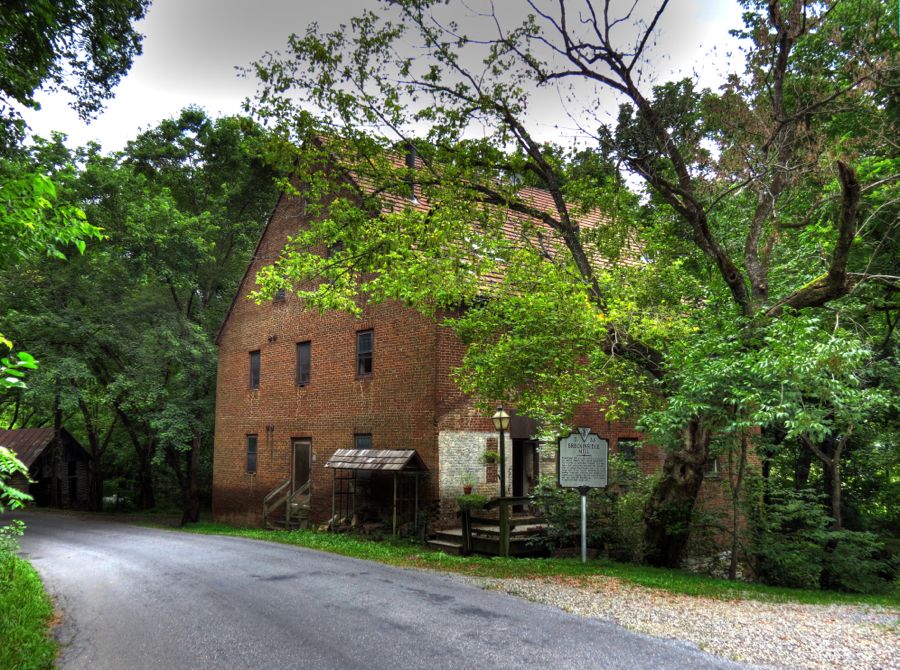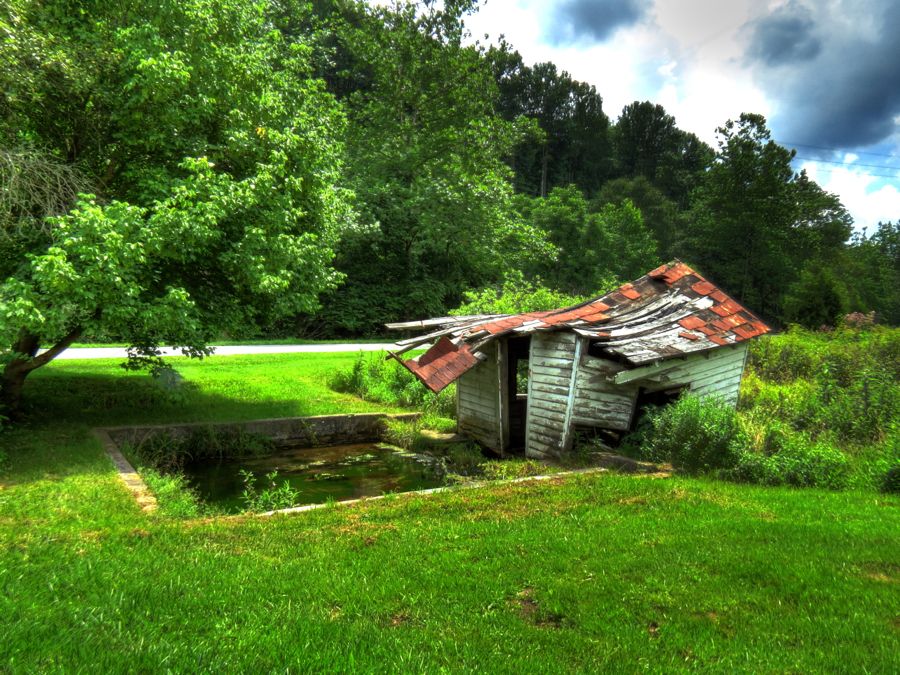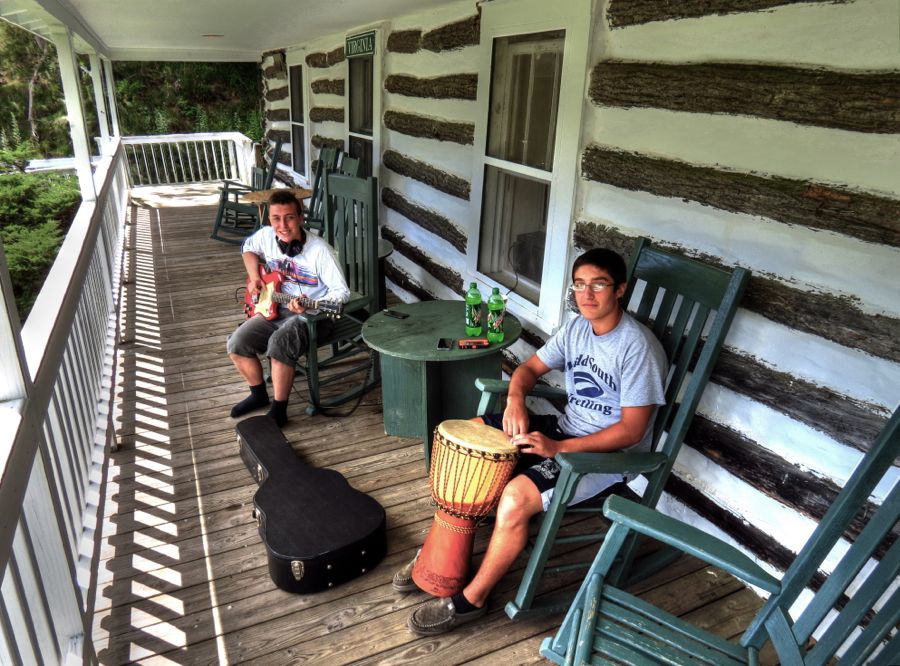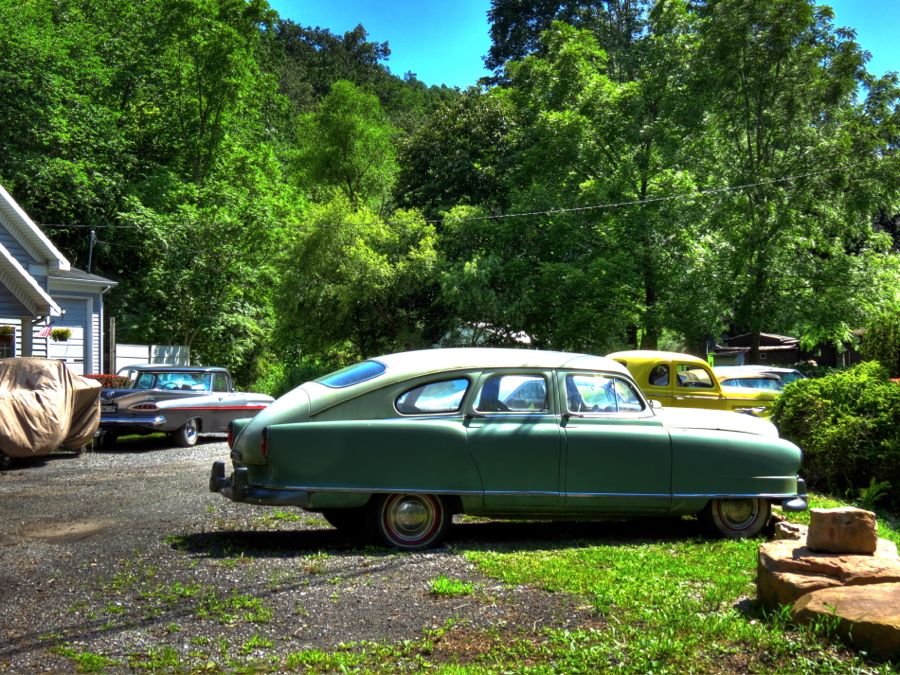Day Two
Remember the troubles I’ve been having with my Garmin Zumo 550 GPS for the last couple of years? I finally bit the bullet and purchased a new, state-of-the-art Garmin Montana 600. During the prior day it had worked flawlessly, but when I clambered back into the Z4, it steadfastly refused to pick up a satellite signal (with or without the external antenna mounted). I had the Zumo as a backup, but it, too, refused to cooperate. After 45 minutes of trying to coax either one of these dimwits into life, I set off on my tour, furiously scrolling the maps by hand and missing every third turn.

It was relatively easy to find the Santillane mansion, where I had hoped to spend the prior night. The original Santillane was built in about 1795 by Colonel George Hancock and his wife Margaret. Their daughter Julia married William Clark at Santillane in 1808, shortly after Clark and Meriwether Lewis returned from their famous expedition to explore the Louisiana Purchase for President Thomas Jefferson. The present mansion was built in 1835 by Henry Winston Bowyer, using the kitchen wing from the earlier home. Santillane definitely qualifies as a place to come back to in the future (with at least 2 days’ notice, of course!)

The next goal was to find the historic Hawthorne Hall farmhouse. It was built in 1824 and still serves as the principal residence for a 179-acre farm. Without either GPS, it took some doing, but I finally found the place, only to discover that it’s almost entirely obscured behind a wall of trees. It was built by an elderly widower, Robert Harvey, for himself and his widowed daughter Mary Harvey Trigg. (Photo courtesy of the Virginia Department of Natural Resources.)

Fortunately, the hillside road back toward civilization offered some nice views.



Now that I’d relocated myself on the static Garmin map, it was easy to find the Breckinridge Mill. At 3˝ stories, it’s one of the larger gristmills I’ve seen, particularly since it dates back to 1822. It continued in operation until 1939.

After retracing my steps back to Route 606, I parked the Z4 in an open space for a while in another vain effort to get the Montana 600 to locate a few of the nearly 20 GPS satellites that were circulating merrily on this relatively clear day. While I waited, I wandered over to get this photo of Catawba Creek, which I would be following for a considerable distance. In the meantime, the elderly Zumo woke up enough to identify the satellites, although the connection subsequently came and went until 12:45 PM, when the Montana finally got its act together. Dang technology!

Somewhere along the way, I spotted this colorful house behind some trees. It appears to have been abandoned, although relatively recently.

Despite my GPS problems, it was a glorious day. The positive effects of sun, wind, sky, and ever-winding roads were gradually improving my mood. And the best was yet to come in the form of five classic old resorts and spas.

The first one I encountered had been the Roanoke Red Sulfur Springs Resort, outside of Catawba, VA. It started in 1858 and soon became very popular with the genteel (and well-heeled) people who traveled from resort to resort in the summer months to “take the waters.” The Catawba sulphur and limestone spring water was especially prized for its medicinal properties. Other spas on the circuit included the white sulfur springs (now the Greenbriar Resort), the hot sulfur springs (now the Homestead Resort), the warm sulfur springs (now, and then for that mater, the Jefferson Baths), the Sweet Springs, and the Sweet Chalybeate Springs. The mineral waters in each were distinct, and entire books were written about how to maximize the health benefits from their mineral properties.
There is almost nothing left of the old Roanoke Red Sulfur Springs at Catawba. These are the only images I could find of the resort, main hotel (which could hold 300 guests), and the gazebo covering the spring’s outlet. Only the last of these still exists, and in planning the trip I’d managed to spot it on Google Maps’ satellite view.



By the late 1800s and early 1900s, business at the mineral springs resorts was slowing—in significant part because many patrons believed, correctly, that consumption (tuberculosis) was spreading at the spas. As demand for mineral springs spas declined, demand for sanatoriums increased, and a number of the former were purchased by States and turned into the latter. Such was the transformation of the Roanoke Red Sulfur Springs into the first of Virginia’s three major tuberculosis sanatoriums, the Catawba Hospital, in 1908. Fresh air was considered the principal cure for consumption, and patients lived and slept in the open air in these “lean to” structures.


The old hotel became the hospital’s administration building (and later its nurses’ residence), and with a new infirmary building the hospital facilities rapidly expanded to treat up to 1,260 inpatient residents at a time.


The advent of thoracic surgery in the 1920s and the development of streptomycin in the late 1940s were finally effective in treating tuberculosis, and over time the sanatoriums were closed—or, in the case of the Catawba Hospital, converted to other uses. Where the Sanatorium’s main infirmary used to stand, today there is the modern Catawba Psychiatric Hospital.


The 1916 Brauer Chapel from the Sanatorium still stands…

…as does the original resort gazebo that shelters the sulfur spring fountain—except that this isn’t it! This one was in the right location, but the real one, with its iron structure, turns out to be a little further on and down a steep slope. I’ll find it the next time.


Leaving the site of the Roanoke Red Sulfur Spring Resort on Catawba Creek Road, I strayed onto an abandoned farm for a brief look. The only signs of life were a very large population of barn swallows, who were either (i) quite happy, or (ii) a bit irritated to see me. It’s a little hard to tell with birds.


The Homeplace Restaurant in Catawba is highly regarded, particularly by hikers along the Appalachian Trail, which runs close by. It started life as The Summit mansion, which dates from 1907. The current owners bought in the late 1970s after it had been vacant for some years, renovated it, and turned it in to the Homeplace.

How’s this for an attractive carport? I suppose that anyone brave enough to actually park a car on this contraption might also be willing to use it as a ramp for working on the car from below…


Eventually I reached New Castle, VA, which is the only incorporated town in Craig County. The county’s historical society is housed in the Old Brick Hotel, which was built around the town’s original, pre-1834 tavern and expanded in the 1850s. The notorious outlaw Jesse James is reputed to have been a guest.


The “new” Craig County Courthouse was completed in 1852, octagonal cupola and all. It was occupied by Union forces in 1864, and the interior staircase still shows signs of sabor slashes. It is now the oldest, unmodified courthouse in Virginia.

New Castle’s old homes range from this basic log cabin…

…to the 1889 Queen-Ann style house built by attorney James Marshall. This view is the back of the house, since the front was undergoing renovation.

Abe E. Humphreys was president of the New Castle Land & Improvement Company, which was formed to promote the expansion and development of the town. They had considerable success during 1900-1920, but the decline of the mining and timber industries, plus the Great Depression, led to a substantial decline in New Castle’s population. (It has remained largely unchanged at about 200 residents ever since). This was Abe’s home in 1890.

Did I mention what a pretty day it was? Or that many of the structures have bright red roofs? In the background is the New Castle United Methodist Church, which sits on land that Abe sold to the church’s trustees for $1.00.

“The Castle” is the most stately mansion in the town. It was built for local merchant and politician Nathaniel Spessard in 1898 at a cost of $7,500.

As I left New Castle and worked my way around the tight turns of Cumberland Gap Road, I found (i) a scenic view overlooking the town (with the red roof of The Castle just visible to the left)…

…(ii) several nifty old houses that looked abandoned, but probably weren’t, such as this one…

…and (iii) this 1883 Methodist church just past Looney, VA, complete with separate entrances for women and men.

I also encountered a lengthy traffic stop for road repaving. For a good 20 minutes, no traffic moved in either direction. Eventually, a county escort truck led us slowly along for a couple of miles, only to stop again while the paving machine was reloaded with asphalt, by another truck blocking our path. The efficiency of the operation left a bit to be desired.


Soon enough, however, I was past the construction and back in the midst of scenic history, such as the vacant 1912 New Bethel Christian Church. Only the barest trace of its original driveway was visible—but I used it anyway.

I loved the tidy and organized Long Oak Farm.

In contrast, the hamlets of Simmonsville and Huffman appear well on their way to ghost-town status.



Most of you have seen or heard of the 1987 movie
Dirty Dancing, starring the late Patrick Swayze and Jennifer Grey. It was set in the Catskills in 1963. I had read that much of the movie was actually filmed at the Mountain Lake Resort near Pembroke, VA, and I decided to see what was left of the old resort.


I managed to find Mountain Lake Road, and the always-willing Z4 tackled the steep uphill climb with relish, enjoying tight turn after tight turn. Around one of these, I encountered a large
owl standing smack in the middle of the road! Surprisingly, it did not fly away as I braked to a complete stop only a few feet shy of the bird. When I reached for my camera, however, it took wing. It was about 2 feet tall, with very prominent white feathers encircling its large eyes. I’m pretty sure it was a barn owl, although these are less common in the mountains.
Given the very rural nature of the road, and the lack of any apparent civilization, I began to wonder whether there would be anything left of the old resort. It had looked like this in the opening scenes from the movie:

To my surprise, it still looks exactly the same. Not only does it still exist, it’s in great shape, and almost all the rooms were filled, even in the middle of the week. (In retrospect, I had driven up the
back way to the lodge; the front way is much more accessible.)

Here are a few more comparisons between the movie scenes and my own photos, 26 years later: The lodge’s dining room was largely unchanged…


…as was the cabin where Baby’s (Jennifer Grey’s) family stayed, although the steps have been relocated. Note, however, that Mountain Lake was very close to the cabin in 1987, but it is no longer nearby today. Did they move the cabin?


Nope—the lake is nearly empty! These pictures of the gazebo were taken from almost exactly the same vantage point. The lake used to lap right at the bottom of the stairs leading to the gazebo. Not any more.


This iconic nighttime scene of Johnny and Baby practicing their dance lift in the lake was filmed just off of the boat dock. Today, it’s a field of grasses and weeds. The natural lake is situated at the top of a mountain, nearly 4,000 feet above sea level, and fed by local springs and streams. It’s been here for roughly 6,000 years, gaining additional water from rain and snowmelt in wet years, and losing a constant flow through the soil and rocks forming the bottom of the lake. As a result, Mountain Lake goes through extended periods of being full or empty, all depending on the volume of precipitation.


This scene shows Baby looking forlorn and wistful on the porch of the cabin. On the day of my visit, I heard a well-played electric guitar and an accompanying djembe drum. Further investigation led me to Tristan and Nick, who have been coming here with their parents every summer for the last 13 years. Tristan is playing his dad’s vintage Gibson SG, while Nick handles the accompaniment; they’ll both be high school seniors this Fall. (For comparison, Baby was standing at the far end of the porch.)


With some reluctance, I took my leave of the Mountain Lake Resort and pressed on toward further adventures. While retracing my steps back toward civilization, I stumbled across two different covered bridges across Sinking Creek that I’d failed to note on the way up. This was a bit remarkable, given that there are only
eight covered bridges in all of Virginia. The first one shown below is the 1912 Link Farm bridge, which is on private property. The second one is the Sinking Creek Bridge, from 1916, which is on public land. Vive les ponts couverts!


Even better than discovering covered bridges is finding interesting old cars. The middle one is obviously a rare 1959 Chevrolet El Camino—the first year for this semi-pickup truck. But what are the first and third cars? I was especially taken with the third; although it’s clearly American, it has unusually handsome, European-like lines. Let the identification begin. (This means you, John!

)



By now it was after 4:00 pm, and I still had three more resorts and many miles to go. I summarily decided that my 2-day trip would now be a 3-day trip. (It’s great to be retired.) As I motored in the general direction of the Craig Healing Springs, I encountered vacant-looking but active barns…

…together with the mother of all vacant houses. Although it’s barely noticeable from the roadside, this thing was mammoth. It’s built right into the hillside, which is probably all that’s keeping it from collapsing.


The first resort hotel at Craig Healing Springs was built in 1885, but business didn’t really take off until the early 1900s. There are more than 20 cottages, a spring-fed swimming pool, and a dance hall/ meeting pavilion here. In this photo, the 1909 building on the right is the dining hall, with the brick one on the left being the Oak Lodge, added in 1935. (Historical photos courtesy of the
Jim Walker Collection at Virginia Tech.)


The 1885 Craig Hotel, now known as Old Central, is shown here on the right. The pool is just to the left of the kids. As business at other resorts was waning, the ease of reaching Craig Healing Springs by automobile made it very popular starting in the early 1920s. By the close of the 1950s, however, most vacationers were going to the beaches, and the resort’s time had come and gone. The Christian Church in Virginia bought the property and has used it as a retreat and summer camp ever since. The facilities have been maintained in their original condition throughout.


Route 658 in Virginia offered great views pretty much everywhere you looked.


Paint Bank, VA is said to have more buffalo than people—although I saw none of the former and precious few of the latter. I did talk with a nice couple who were out for a ride on their new Triumph Tiger 1200. And I briefly joined the “Girls’ Club” on the front porch of the Paint Bank General Store. (The local gossip was pretty much what you would expect from a town with more buffalo than people…)

The store featured an eclectic collection of foods and products, a swinging bridge that used to cross a stream (and now crosses from one part of the second floor to another, right over the tables in the Swinging Bridge Restaurant), and a t-shirt that reads “End of the World 9 miles, Paint Bank 12 miles.” (For the record, I made it across the restaurant’s swinging bridge.)

Behind the store, Tingler’s Mill is still in good repair after 150 years.

But Paint Bank was just the jumping off point for my pursuit of the final two mineral springs resorts. For that, I had to take Route 311 north to the Virginia-West Virginia border. Like every other road I’d been on throughout this trip, 311 proved to be a continuous series of curves, one right after the other. Great fun, even if you are trying to reach an actual destination on time!

Red Sweet Springs, later called Sweet Chalybeate Springs, dates back to 1836 and was a smallish resort that tended to handle the overflow from the nearby White Sulfur Springs and Old Sweet Springs. The waters were characterized as “the strongest carbonated mineral water in America and a certain cure for sterility.” In contrast to the Greenbriar and Homestead resorts, which had direct access by train, Red Sweet Springs required a challenging stage coach ride, and this resort never achieved the same popularity. By 1918, its doors were closed. The springs remain, however, and continue to pump out 600 gallons a minute.




From left to right in this 1974 photo (courtesy of the Library of Congress), we can see the north resort lodge, two cottages, and the south or “main” lodge—i.e., the one with the bar. The main lodge is no longer standing, but the larger northern one is still there, as are the cottages. “Bachelors’ Row” isn’t visible in the old photo, but it still exists. It was situated across Route 311 and on top of a hill due to the “sometimes rowdy good spirits of the bachelors.” The whole works is barely visible from Route 311, and one would never guess that this used to be a thriving resort area.


Just a mile down 311, and perched barely within what is now West Virginia, I found the glorious Old Sweet Springs resort. It started as a few log cabins in 1790 but soon became a massive facility and a major stop on the springs tour in the 1800s, rivaling the Greenbrier and Homestead in popularity. Its original developer, William Lewis, even built a four-county courthouse and jail on the edges of the property to promote settlement of the area. Six U.S. Presidents stayed at Sweet Springs, including George (and Martha) Washington and James (and Dolly) Madison. Other notable visitors included the Marquis de Lafayette, Henry Clay, Robert E. Lee, and Queen Victoria of England. Virtually unchanged from its original design, no other place in the country better reflects what resort life was like in the 1800s for “fashionable society.”


The extraordinary main hotel building was built in 1833. Its design is widely attributed to Thomas Jefferson, although later research suggests that one of Jefferson’s architectural colleagues actually drew up the plans. The “Grand Hotel” (or “Jefferson Building,” as you wish) is still in remarkably good condition. As best I can tell, it was the first hotel in the U.S. to use natural gas for lighting.



The resort’s ballroom still stands next to the hotel.

In a semi-circle off the end of the Jefferson Building were five brick cottages, referred to as “the Five Sisters.” Two have survived largely intact, but only the foundations remain for two others. As for the fifth “sister,” I suspect that it was converted into the ballroom sometime back in the day.


And what about the spring, that produces a steady flow of iron- and carbon dioxide-rich waters at exactly 73 degrees and that were said to “quicken the circulation, impart tonicity and vigor to the system, excite the animal passions, cheer the spirits, and inspire the mind with pleasureable sensations”? An elaborate bathhouse was built to house a fountain and pool fed by the spring. It featured towers at either end of the structure, providing separate entrances for men and women.



Unfortunately, both towers have collapsed within the last 10 years or so, but most of the rest of the bathhouse has survived. The pool could use a good cleaning, it seems, although the bright-colored algae, salamanders, and other flora and fauna added a festive appearance to the spring waters.




Sweet Springs closed during the Civil War and never fully regained its prior popularity. After the resort was finished off by the Great Depression and sat vacant for 12 years, the State of West Virginia purchased it in 1941 for the treatment of tuberculosis patients. The sanatorium was converted to a home for the elderly in 1945 and operated as such until closing in 1993.
Remember the courthouse and jail from the late 1700s? Well, against all odds, the jail is still there. It is believed to be the oldest jail west of the Allegheny Mountains.

As a postscript to the Old Sweet Springs story, Warren Smith—a prominent Fredericksburg businessman and member of the National Trust for Historic Preservation—purchased the property in 2004 with the intent to renovate it, rebuild the 1800s golf course, and return the resort to its former glory. To raise funds for the project, he began marketing the spring water as “Sweet Sommer” bottled water and entered—and
won—several international water-tasting competitions. By 2009, however, his business ran afoul of the FDA—and you don’t want to know the
details… Following his death in November 2010, the water business closed down, and the resort has sat untouched. But if Bedford Springs can do it (see
Sometimes They Come Back to Life), maybe there’s still hope for this once-magnificent resort.
After hiking around Sweet Springs for quite a while (and possibly climbing through a fence or two), it was time to press on. I completed my planned tour, arriving back in Covington well after dark and enjoying a hearty, vending-machine dinner. Tomorrow would be time to head for home—but with a couple off-the-beaten-path detours, of course!